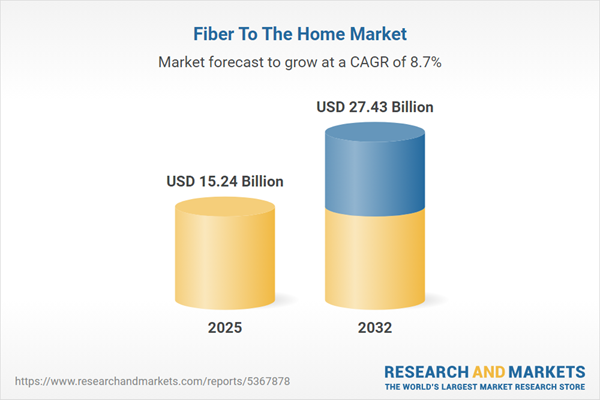Speak directly to the analyst to clarify any post sales queries you may have.
The fiber to the home market is transforming organizational connectivity, driving digital modernization and efficiency for businesses adapting to rapidly changing operational needs.
Market Snapshot: Fiber to the Home Market Trends and Growth
The global fiber to the home market is experiencing steady expansion, with market size forecasted to rise from USD 14.09 billion in 2024 to USD 15.24 billion in 2025, and expected to reach approximately USD 27.43 billion by 2032, growing at a compound annual growth rate of 8.68%. Growth is fueled by escalating demand for consistent, high-capacity broadband to support digital transformation in commercial and residential settings. Advanced optical networking, progressive regulatory frameworks, and ongoing investment in new and upgraded infrastructure continue to propel the industry, as organizations pursue agile connectivity, sustainability, and service reliability.
Scope & Segmentation: Strategic Insights for Senior Fiber to the Home Market Decision-Makers
This report offers targeted segmentation and practical analysis to inform strategic investment and operational decisions, focusing on the priorities of executive stakeholders in both established and emerging markets. Key coverage areas include:
- Technologies: Includes Active Ethernet, EPON, and GPON, which each support scalable and robust network management suited to diverse organizational requirements.
- Components: Covers essential system elements such as Optical Line Terminals, Optical Network Units, splitters, connectors, and fiber optic cables, critical for broadband dependability.
- Service Types: Encompasses Double Play, Triple Play, and custom bundle options across internet, voice, and video, enabling providers to address both business and residential user needs.
- Deployment Models: Reviews both Brownfield upgrades for updating legacy infrastructure and Greenfield installations for new construction, supporting broadband expansion tailored to varying regional project demands.
- End Users: Considers the requirements of commercial organizations emphasizing secure, reliable operations, alongside residential consumers seeking high-speed, consistent connectivity.
- Regional Markets: Describes market activity in the Americas, EMEA, and Asia-Pacific, shaped by region-specific regulations, technology life cycles, and capital allocation, highlighting the United States, China, and India as comparative benchmarks.
- Corporate Profiles: Examines top companies such as China Telecom, China Mobile, Verizon Communications, KT Corporation, and Orange, focusing on partnerships, innovation agendas, and their impact on sector competitiveness.
Key Takeaways for Senior Leaders
- Infrastructure modernization efforts support adaptable, resilient service delivery to address changing user requirements and maintain competitiveness for both commercial and residential markets.
- Leveraging digital platforms such as cloud and Internet of Things technologies allows organizations to streamline processes and respond proactively to evolving connectivity needs.
- Adopting flexible business strategies and deployment options enables organizations to manage challenges related to regulatory shifts and rapid technological change in global markets.
- Offering customizable service bundles helps providers meet specific client expectations, ensuring continued customer engagement despite shifting industry trends.
- Forging strategic partnerships and maintaining alignment with technology standards reduces rollout risks and sustains service reliability across regions.
- Effective supply chain and procurement management strengthens operational continuity, which is essential during periods of economic unpredictability.
Tariff Impact: Navigating Trade Policy Changes
Recent changes in U.S. tariff regulations affecting fiber optic components are prompting organizations to broaden sourcing approaches and explore new supplier partnerships, including options for increasing domestic production. These supply chain adaptations support greater operational stability and are especially valuable to small and mid-sized service providers dealing with evolving international trade policy.
Methodology & Data Sources
This analysis integrates secondary market research, direct interviews with industry executives, and sector-specific survey data. All conclusions are anchored in regulatory filings, recognized white papers, and intellectual property reviews to ensure findings are accurate, timely, and actionable.
Why This Fiber to the Home Market Report Matters
- Provides senior executives the context needed to develop and execute tailored investment and infrastructure strategies aligned with regional nuances and connectivity trends.
- Clarifies new developments in regulation and technology, supporting effective risk management and agile project execution across different market conditions.
- Delivers practical intelligence to optimize procurement, stimulate service innovation, and drive large-scale digital transformation throughout the broadband delivery chain.
Conclusion
Fiber to the home enables organizations to advance operational resilience and digital responsiveness. This report supports senior leaders in shaping strong, adaptive network strategies amid continually shifting business and technology environments.
Additional Product Information:
- Purchase of this report includes 1 year online access with quarterly updates.
- This report can be updated on request. Please contact our Customer Experience team using the Ask a Question widget on our website.
Table of Contents
3. Executive Summary
4. Market Overview
7. Cumulative Impact of Artificial Intelligence 2025
Companies Mentioned
The companies profiled in this Fiber To The Home market report include:- China Telecom Corporation Limited
- China United Network Communications Group Co., Ltd.
- China Mobile Communications Group Co., Ltd.
- Chunghwa Telecom Co., Ltd.
- NTT East Corporation
- NTT West Corporation
- KDDI Corporation
- Orange S.A.
- KT Corporation
- Verizon Communications Inc.
Table Information
| Report Attribute | Details |
|---|---|
| No. of Pages | 190 |
| Published | November 2025 |
| Forecast Period | 2025 - 2032 |
| Estimated Market Value ( USD | $ 15.24 Billion |
| Forecasted Market Value ( USD | $ 27.43 Billion |
| Compound Annual Growth Rate | 8.6% |
| Regions Covered | Global |
| No. of Companies Mentioned | 11 |









